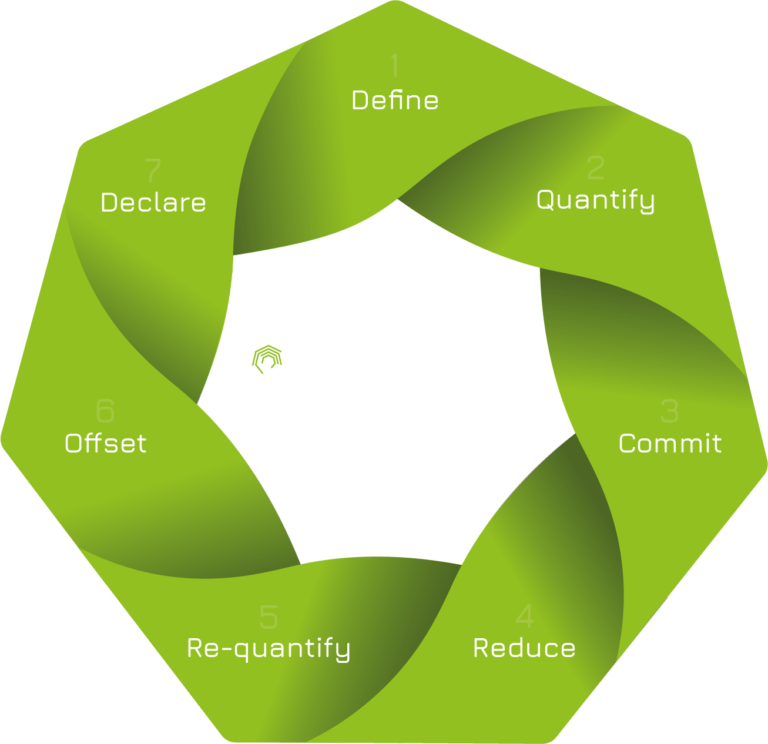As the climate crisis continues to intensify, increasing numbers of businesses are recognising the need to take responsibility for their carbon emissions. One frequently adopted strategy to achieve this is by aiming for carbon neutrality, balancing the amount of greenhouse gas (GHG) emissions released with an equivalent amount removed from, or prevented from, entering the atmosphere. Achieving carbon neutrality generally involves a two-pronged approach: first, taking all possible steps to reduce a company’s emissions, and second, offsetting any remaining emissions by supporting external projects that result in verifiable emission reductions. This is where the concept of carbon offsetting comes into play.
Carbon offsetting involves purchasing and retiring carbon credits, with each credit representing one tonne of carbon dioxide equivalent (CO2e) that has been removed from, or not released into, the atmosphere by the project. It is crucial to note that offsetting is not a substitute for taking direct action to reduce one’s carbon footprint but plays a complementary role in achieving a net-zero-emission status.
Types of Carbon Offset Projects
Carbon offset projects come in various forms, each aiming to reduce greenhouse gas emissions in a unique way. Here are four main types of projects businesses can support to offset their carbon emissions:
1. Renewable Energy Projects: Supporting the development and operation of renewable energy projects, such as wind, solar, or hydroelectric power, helps to replace fossil fuel-based energy and reduce overall greenhouse gas emissions. These projects promote the use of clean technology and encourage a shift towards sustainable energy sources.
2. Forestry and Land Use Projects: These initiatives may involve afforestation, reforestation, or forest conservation, all of which contribute to carbon sequestration or the prevention of CO2 emissions through the preservation of existing carbon sinks. In addition to the climate benefits, these projects can also provide significant ecological, social, and economic advantages.
3. Energy Efficiency Projects: By investing in projects that enhance energy efficiency or implement cutting-edge technologies, businesses can help to reduce energy consumption and related greenhouse gas emissions. Examples include upgrading industrial processes, improving building insulation, or transitioning to energy-efficient lighting and appliances.
4. Methane Avoidance and Capture Projects: Methane, a potent greenhouse gas, can be captured and destroyed through initiatives such as landfill gas capture, biogas production, and coal mine methane capture. These projects not only reduce emissions but also contribute to renewable energy production when the captured methane is used as a fuel source.
Choosing Reputable Offset Providers and Projects
When selecting an offset provider and project to support, it is essential to ensure their credibility and the effectiveness of the emission reductions they claim. Businesses should perform thorough due diligence to assess the background and reputation of the offset provider and investigate the specific details of the proposed project. Key criteria to evaluate include:
1. Additionality: The project should demonstrate that the emission reductions would not have occurred without the support provided through the sale of carbon credits. This can be established through a rigorous assessment process, comparing the project against a baseline scenario that reflects business-as-usual circumstances.
2. Permanence: Projects should provide long-term and reliable emission reductions. While this can be challenging to guarantee, especially for forestry and land use projects, mechanisms should be in place to minimise the risk of future emissions, such as buffer reserves and strict monitoring systems.
3. Leakage: The project should not lead to increased emissions elsewhere, negating the intended emission reductions. This is particularly relevant for forestry and land use projects, where the displacement of fossil fuel consumption or deforestation to other areas must be prevented.
4. Co-Benefits: Preferably, the project should provide additional environmental, social, and economic benefits, such as improved air quality, enhanced biodiversity, job creation, or support for local communities.
Carbon Offsetting Standards and Certifications
One method of ensuring the credibility of carbon offset projects is to rely on projects certified by recognised standards, such as ISO 14064 and PAS 2060. These standards establish transparent guidelines and requirements for the quantification, monitoring, reporting, and verification of greenhouse gas emissions and reductions, promoting reliability and quality in the carbon offset market.
- ISO 14064: This international standard, developed by the International Organization for Standardization (ISO), comprises a three-part series, focusing on organisational and project-level greenhouse gas accounting and the validation and verification of the reported information. ISO 14064 certification ensures the consistency, robustness, and transparency of a carbon offset project’s data and emission reduction claims.
- PAS 2060: Developed by the British Standards Institution (BSI), the Publicly Available Specification (PAS) 2060 provides a framework for demonstrating carbon neutrality. Aimed at organisations, products, and events, this standard establishes specific requirements for quantifying and reducing greenhouse gas emissions, offsetting residual emissions, and disclosing certification and transparency information.
Conclusion
Carbon offsetting plays an essential role in a company’s journey towards achieving carbon neutrality. By supporting reputable carbon offset projects and adhering to internationally recognised standards, such as ISO 14064 and PAS 2060, businesses can ensure their investments are contributing to genuine and verifiable emission reductions.
However, it is crucial to remember that carbon offsetting should be used only alongside active efforts to reduce a company’s direct emissions. By combining these strategies, organisations can work towards a more sustainable future, playing a vital part in the global fight against climate change and positioning themselves as leaders in environmental responsibility.
Carbonology leverages extensive experience and innovative thinking to help businesses become carbon-neutral and successfully meet ISO Standards. We provide the most comprehensive consultancy services related to reducing carbon emissions and adhering to Carbon Standards. Our unique, tested method ensures attainment of the highest benchmarks in Carbonology. Ask us about our carbon reduction plan today!

